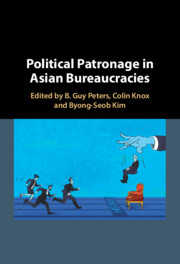Book contents
1 - Patronage in Asian Political Systems
A Framework for Research
Published online by Cambridge University Press: 05 October 2023
Summary
This framework chapter for the edited collection begins with a definition of political patronage adopted from existing research: the power of political actors to appoint individuals, using their own discretion, to non-elective positions in the public sector, irrespective of the legality of the decision. These individuals tend to be directly involved in making public policy. The book is about patronage appointments in bureaucracies in Asian countries, some with well-developed civil service systems and minimal patronage, some with high levels of patronage and a weak civil service, and others between these extremes. The framework chapter develops a typology of patronage types based on two primary criteria: basis of trust (political or personal loyalty to: the political party, politician, or a group); and, the major role of political appointees (the extent to which they influence public policy). Each of the countries in the edited collection tests the appropriateness of this typology for individual Asian case studies illustrating the fact that not all patronage is the same and what is important is the tasks being performed by appointees and the nature of the trust relationship.
Keywords
- Type
- Chapter
- Information
- Political Patronage in Asian Bureaucracies , pp. 1 - 22Publisher: Cambridge University PressPrint publication year: 2023
References
- 1
- Cited by



